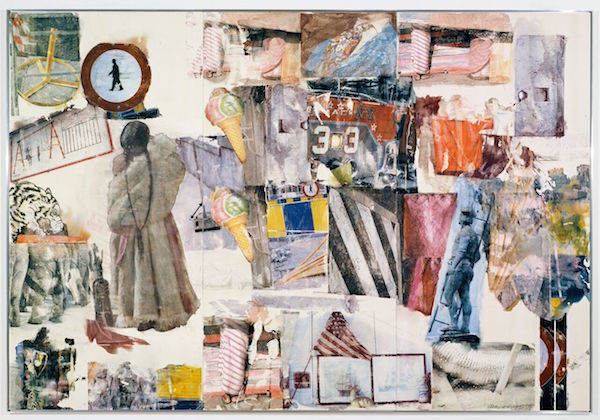|
Mixing It Up & Mesmerizing with Robert Rauschenberg at SFMoMA Since the San Francisco Museum of Modern Art (SFMoMA) reopened its doors a year and a half ago, showcasing a substantial transformation, it has rivaled all of its museum counterparts throughout the country, including the New York Museum of Modern Art. Beyond the physicality of the space, which covers several floors, is large, looming and light-filled, both the permanent and rotating exhibits have been impressive and captivating, without being overwhelming. Keeping with that pattern and taking full advantage of space, the museum is launching the winter 2017 exhibit season with an extensive and special retrospective of Robert Rauschenberg’s work. This West Coast exclusive presentation, titled “Robert Rauschenberg: Erasing the Rules,” includes an eclectic and voluminous array of work amassed from the artists 60-year career. When Rauschenberg came on the scene, he redefined what art could be, refusing to be confined to a single medium or style. He relocated from Texas to New York early in his career in 1949. At that time in New York, Abstract Expressionism was prevalent. It was a movement that reflected boldness, broad strokes and the emotion of the artist. While Rauschenberg appreciated the style and was clearly influenced by it, he was determined not to be limited to it or defined by it. He wanted to reflect the new world he inhabited. All the elements in his environment, social circles and dealings with fellow artists, played a great part in who he became as an artist and what he produced. He cherished the sights and sounds of the big city, and unabashedly presented it in his work. Paper, metals, mirrors, liquids, wood; painting, photography, video and sound were elements that excited Rauschenberg and fed into his work. He may not have been the pioneer of such mixed art, but he quite possibly was the first to elevate to such a level of extravagance and capacity. He had an outgoing personality, a zest for life and a love for other artists, beyond painters. Never playing the part of the typical “isolated artist,” he worked out in the streets as much as the studio, if not more so. He thrived in collaborative settings and appreciated his contemporaries including Willem de Kooning and Jasper Johns. It wasn’t enough to put paint to canvas, he incorporated dance, sounds and found objects to his art. Politics and social issues found their way into much of his work, and he proved to be ahead of his time, with an unrivaled talent to fuse art and technology as early as 1967. Subtlety and restraint were not in his wheelhouse, and a fear of criticism did not determine his artistic endeavors. This mixing and meshing, and wild, yet carefully executed presentation saturated Rauschenberg’s mindset and became the demarkation of his style. All of this is on full display at SFMoMA current exhibit. Large in scope, the exhibit unfolds throughout 10-12 rooms, with each featuring certain types of his art. Individually and collectively the art and overall exhibit are imbued with all the energy, whimsy, color and life that is Rauschenberg. The exhibition continues by presenting key periods of the artist’s career in depth, including a gallery devoted to transfer drawings and silkscreen paintings. For the Thirty-Four Illustrations for Dante’s Inferno (1958–60), Rauschenberg clipped pictures from magazines and newspapers, illustrating Dante’s epic poem with images from contemporary American life. Rauschenberg’s merging of classical themes, art history references, contemporary politics and pop culture culminate in the silkscreen paintings, such as the vibrant Scanning (1963) and Persimmon (1964). Rauschenberg also actively explored technological innovations for his performances and artworks in the early 1960s. Collaborations with Billy Klüver and a team of engineers lead to the inclusion of embedded radios in Oracle (1962–65). For the sound-activated work Mud Muse (1968–71) the artist constructed an enormous vat of vigorously spurting and bubbling mud. Originally conceived for an exhibition in Los Angeles and inspired by a hydrothermal basin in Yellowstone National Park, this presentation marks Mud Muse’s first return to California since 1971. As a prolific artist, with a six decade long career, there’s an abundance to take in, so visitors should plan to set aside enough viewing time, especially if other exhibits will be included. Formerly presented at Tate Modern, London, and the Museum of Modern Art, New York, organizers at SFMoMA say this iteration of the exhibit “pays special tribute to SFMOMA’s close and longstanding relationship with Rauschenberg.” ROBERT RAUSCHENBERG: ERASING THE RULES is on view now through March 25, 2018. Check the museum’s website for times and cost. https://www.sfmoma.org/tickets/
0 Comments
Leave a Reply. |
AuthorPaula Farmer Archives
September 2022
Categories |

 RSS Feed
RSS Feed